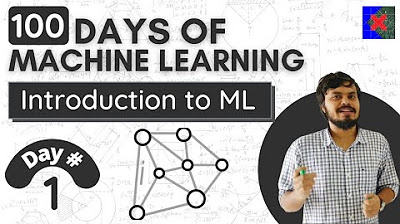Tutorial 23- Operation Of CNN(CNN vs ANN)
Summary
TLDRIn this 23rd tutorial of the deep learning playlist, Krishna apologizes for the delay in uploading due to technical issues and promises continuous uploads to complete the series within two weeks. The video focuses on the operations of CNNs, contrasting them with ANNs. It explains the convolution operation, the role of filters (kernels) in edge detection, and how weights are updated during backpropagation. Krishna also hints at discussing max pooling and the concept of 'location invariance' in future videos. For those interested in transitioning to data science, Krishna recommends a resource from Springboard India.
Takeaways
- 😀 The speaker, Krishna, apologizes for the delay in uploading the 23rd tutorial in his deep learning playlist.
- 📈 The tutorial focuses on the operations of CNNs (Convolutional Neural Networks) and their differences from ANNs (Artificial Neural Networks).
- 🔍 Krishna explains the convolution operation, detailing how filters or kernels are used for tasks like edge detection in images.
- 👓 The script mentions that the speaker has previously discussed padding and convolution operations in earlier tutorials.
- 💡 The tutorial aims to clarify how weights in CNNs are updated, particularly after the convolution operation.
- 📊 Krishna uses diagrams to contrast the operations of ANNs and CNNs, highlighting the multiplication of weights and inputs followed by an activation function in both.
- 📚 The speaker plans to cover max pooling in an upcoming video, which is another important operation in CNNs.
- 🧠 The script touches on the concept of 'location invariant' in CNNs, inspired by how human brains recognize features in images regardless of their location.
- 🔗 Krishna provides a link to a resource for those interested in transitioning to data science or seeking advice from real-world data scientists.
- 🎓 The tutorial concludes with an invitation to subscribe to the channel and a promise of more in-depth discussion on max pooling in the next video.
Q & A
What is the main topic of the 23rd tutorial in Krishna's deep learning playlist?
-The main topic of the 23rd tutorial is the operations of CNN (Convolutional Neural Networks), focusing on the basic differences between ANN (Artificial Neural Networks) and CNN operations.
Why did Krishna skip many days before uploading this tutorial?
-Krishna skipped many days due to some problems he had to resolve, which involved setting up his recording environment properly.
What is the purpose of the filters or kernels in a CNN?
-Filters or kernels in a CNN are used for tasks such as horizontal and vertical edge detection, and they help in feature extraction from images.
How does the convolution operation update the filters in a CNN?
-The convolution operation updates the filters through the backpropagation process, where the weights inside the filter are learned and updated based on the output and loss calculated.
What is the role of the activation function in both ANN and CNN?
-The activation function in both ANN and CNN is used to introduce non-linearity into the model. It is applied to the output of each neuron after the weighted sum and bias addition to introduce complex patterns.
What is the significance of the term 'location invariant' mentioned in the script?
-The term 'location invariant' refers to the ability of a CNN to detect features at different locations in an image, making the model robust to the position of the object within the image.
Why is max pooling important in CNNs according to the script?
-Max pooling is important in CNNs because it helps in reducing the spatial dimensions of the output from the convolution layer, which in turn reduces the number of parameters and computation in the network, thus controlling overfitting.
What is the difference between the operations in ANN and CNN as described in the script?
-The main difference lies in how the networks process data. While ANN uses a full connection between layers, CNN uses filters that slide over the input to perform convolution operations, which is more efficient for image data.
How does the script explain the process of a convolution operation with an example?
-The script explains the convolution operation by taking an example of a 3x3 filter applied to a part of an image, demonstrating how the filter values are multiplied with the image pixels and summed up to produce a single output value in the feature map.
What advice does Krishna offer for those looking to transition into data science?
-Krishna suggests visiting a channel called 'Springboard India' for discussions and advice related to transitioning into data science and becoming a real-world data scientist.
What is the significance of stacking multiple convolutional layers in a CNN?
-Stacking multiple convolutional layers allows the network to learn hierarchical features, where each layer can detect increasingly complex patterns, starting from edges to more abstract features like shapes and textures.
Outlines

Esta sección está disponible solo para usuarios con suscripción. Por favor, mejora tu plan para acceder a esta parte.
Mejorar ahoraMindmap

Esta sección está disponible solo para usuarios con suscripción. Por favor, mejora tu plan para acceder a esta parte.
Mejorar ahoraKeywords

Esta sección está disponible solo para usuarios con suscripción. Por favor, mejora tu plan para acceder a esta parte.
Mejorar ahoraHighlights

Esta sección está disponible solo para usuarios con suscripción. Por favor, mejora tu plan para acceder a esta parte.
Mejorar ahoraTranscripts

Esta sección está disponible solo para usuarios con suscripción. Por favor, mejora tu plan para acceder a esta parte.
Mejorar ahoraVer Más Videos Relacionados

Tutorial 1- Anaconda Installation and Python Basics

Generative AI using LangChain | GENAI for Beginners | CampusX

What is Machine Learning? | 100 Days of Machine Learning

Berapa Kali Sehari Upload Video Short Biar Banyak Yang Nonton

1. Get Started with Horilla Development | Free HRMS Software | Open Source HR Software| Horilla HRMS

BUSINESS LAW BCOM 1ST YEAR | SYLLABUS DISCUSSION | 2022-23 | B.COM/BBA ETC
5.0 / 5 (0 votes)
